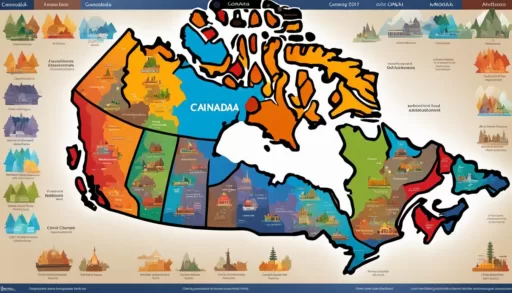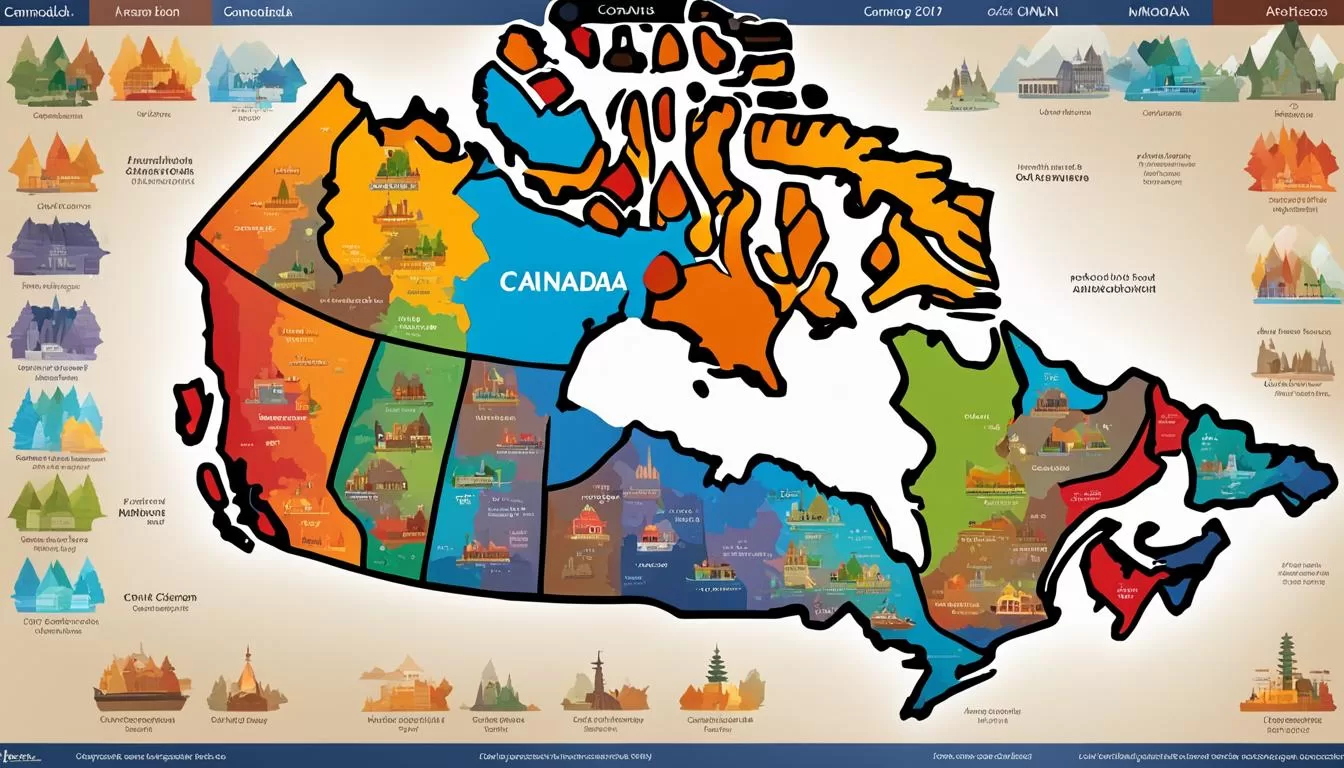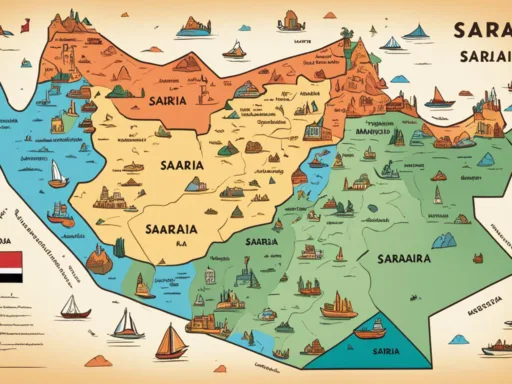From the bustling streets of Toronto to the picturesque landscapes of the Yukon, the languages spoken in Canada paint a vibrant picture of the country’s rich heritage. Distinguished by its Canadian language diversity, the nation gracefully balances the use of official languages Canada — English and French — while embracing a multitude of Indigenous and immigrant languages. This blend of tongues represents not only the historical facets of Canada’s past but also the evolving dynamics of its present and future as a hub of cultural amalgamation.
Key Takeaways
- English and French serve as the foundation of Canada’s linguistic identity, being the official languages.
- Indigenous languages reflect the profound cultural roots and the ongoing efforts for preservation.
- Immigrant languages continue to shape Canada’s multicultural society, contributing to its diversity.
- Legislation and community initiatives highlight the importance of bilingualism and linguistic inclusivity.
- Statistics offer insights into the shifting patterns of language use across different Canadian regions.
- The sustained growth of languages like Mandarin and Punjabi underscores Canada’s changing linguistic landscape.
Overview of Canadian Linguistic Landscape
The intricate tapestry of languages in Canada is a testament to the nation’s commitment to bilingualism in Canada, its celebration of rich Indigenous tongues, and its embrace of multiculturalism in Canada. As we delve into the Canadian linguistic landscape, we uncover the nuanced interplay between its storied past and dynamic present.
The Official Languages of Canada: English and French
At the heart of Canadian communication are its two official languages: English in Canada and French in Canada. Upheld by the Official Languages Act of 1969, bilingualism is a cornerstone of the nation’s identity, fostering a society where both languages flourish. English, while dominant across most of the country, shares the stage with French, which shines as the primary language in Quebec and in Francophone communities dotting the nation.
Indigenous Languages: A Rich Cultural Heritage
Canada’s linguistic heritage is deeply rooted in the diverse and rich Indigenous tongues that predate European colonization. Stretching from the Algic to the Salishan language families, these languages are more than a means of communication—they are the living embodiments of Canada’s First Nations peoples’ storied pasts, beliefs, and identities.
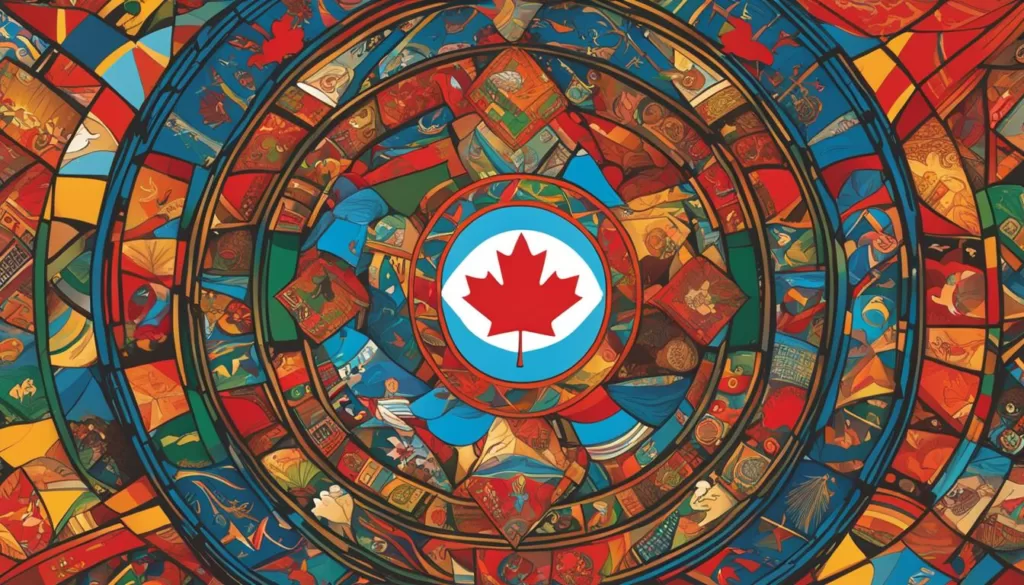
The Rise of Multilingualism and Immigrant Languages
The landscape of Canadian language use extends beyond English and French, reflecting the growing multiculturalism in Canada. New immigrant languages, such as Mandarin, Punjabi, and Arabic, have gained traction, enriching the nation’s linguistic mosaic. This shift signals an ongoing transformation as Canada continues to welcome new cultural influences and languages into its midst.
| Language | Spoken at Home | Mother Tongue |
|---|---|---|
| English | 56.0% | 65% |
| French | 21.4% | 20% |
| Mandarin | 1.5% | 1.3% |
| Punjabi | 1.4% | 1.4% |
| Indigenous Languages | 0.6% | Varies by community |
English and French: Canada’s Official Languages
In a nation as culturally and linguistically diverse as Canada, the role of its official languages—English and French—becomes ever more pivotal. The interaction between these languages and their prevalance across provinces creates an intricate lingual tapestry, reflective of the nation’s identity and federal language policies.

English Predominance Outside Quebec
The linguistic landscape outside Quebec is significantly marked by the English predominance, making it the main language of communication, business, and media. Provinces such as Ontario, Manitoba, and Alberta have recognized English as an official language, with a substantial majority of their populations fluent in English. This widespread usage reflects the nation’s historical and ongoing preference for the English language, further substantiated by policies promoting its use in government and education sectors.
French in Quebec and Other French-speaking Communities
French-speaking communities in Canada, while more concentrated in Quebec, also have a significant presence in provinces like New Brunswick and Ontario. French holds a place of prestige in Quebec as the official provincial language, influencing local culture and provincial governance. The distinctiveness of Quebec’s French-speaking society has necessitated unique language policies, including the Charter of the French Language, to protect the usage of French within the province.
Bilingualism and Federal Language Policies
The Canadian government’s dedication to a bilingual society is evident in its federal language policies, which aim to preserve and enhance the stature of both English and French across the country. The Official Languages Act serves as the backbone of this commitment, ensuring citizens receive federal services in their language of choice. Efforts to maintain this bilingual equilibrium are widespread—as seen in Nova Scotia’s recognition of Mi’kmawi’simk—signaling an encompassing approach to language preservation and recognition in Canada.
Languages Spoken Canada: Examining the Statistics
The texture of Canada’s language landscape is as diverse as its population, with the Canadian statistics on language reflecting a country at the crossroads of tradition and change. The most recent census data reveals that an overwhelming 75.5% of Canadians count English as their primary official language. French, meanwhile, remains the primary official language for 21.4% of the population.
Yet, a deeper look into the languages spoken Canada provides an intriguing glimpse into the nation’s bilingualism. An impressive 18.0% of Canadians are proficient in both English and French, with a higher degree of bilingualism inside Quebec compared to other provinces.
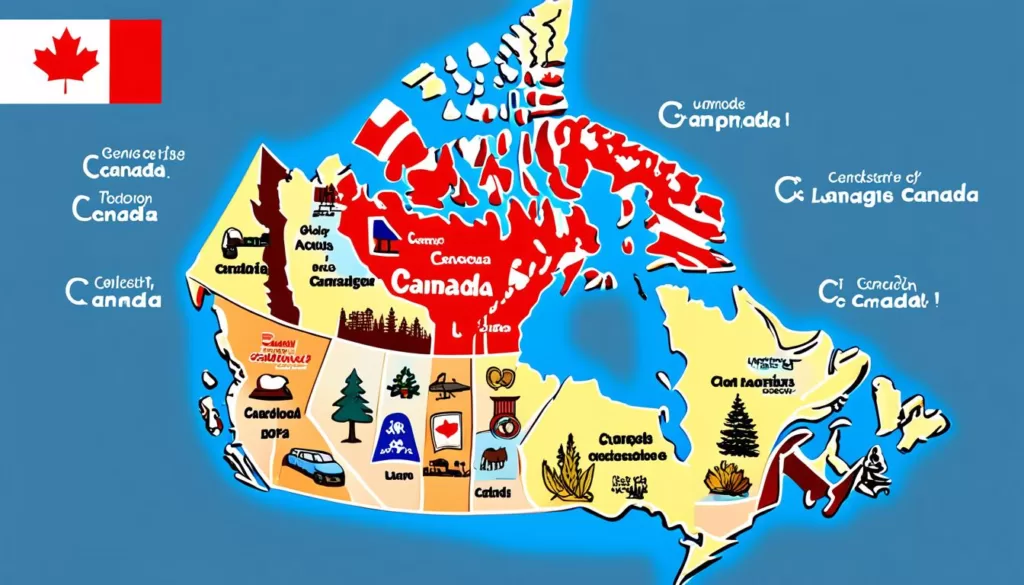
Further enriching Canada’s linguistic tapestry, the data notes a steady rise in the number of Canadians who primarily use languages other than English or French at home. This trend, sustained over the past 30 years, signals an expanding embrace of linguistic diversity within Canadian society. Of these languages, Mandarin and Punjabi have emerged as prominent players, underscoring the increasing cultural and economic ties between Canada and Asia.
Indigenous languages continue to play a critical role in Canada’s cultural identity. Despite the challenges they face, languages such as the Cree languages and Inuktitut are spoken regularly at home by hundreds of thousands, pointing to the persistent vibrancy and importance of these native tongues.
| Language | First Official Language Spoken | Bilingual (English-French) | Predominantly Spoken at Home (Non-Official) |
|---|---|---|---|
| English | 75.5% | 18.0% | N/A |
| French | 21.4% | N/A | |
| Mandarin | N/A | N/A | Significant Increase |
| Punjabi | N/A | N/A | Significant Presence |
| Indigenous Languages | N/A | N/A | Regular Use at Home |
This tableau of tongues illustrates more than mere numbers—it tells the story of a nation continually reshaping its identity through the languages its people speak. As Canada’s demographics evolve, so too does its linguistic landscape, promising a future as polyphonic as its people.
The Growing Diversity of Languages in Canada
As a nation that epitomizes multiculturalism, Canada’s evolving language diversity is both a reflection of its open arms to newcomers and a tribute to the historical depth of its Indigenous roots. With every new wave of immigration and every community initiative to preserve native tongues, the linguistic landscape of Canada becomes even richer.
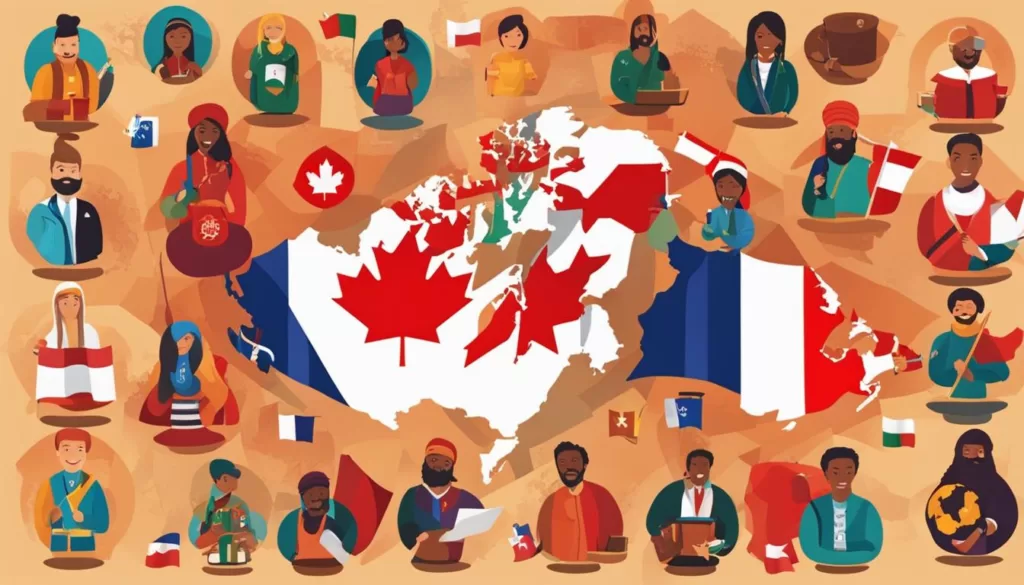
Immigrant Languages Reshaping the Canadian Mosaic
The impact of immigration on Canada’s language diversity is unmistakable. A significant rise in immigrant languages, including Mandarin, Punjabi, Hindi, and Malayalam, marks a pivotal shift in the communicative fabric of the country. This remarkable infusion of new tongues illustrates not only a demographic transformation but also shines a spotlight on the ever-changing face of the Canadian mosaic.
Among these, Mandarin and Punjabi have made a substantial foothold, with over half a million Canadians speaking these languages predominantly at home. The trend is clear: as Canada continues to expand its horizons, embracing immigrants from diverse linguistic backgrounds, the tapestry of languages spoken within its borders becomes increasingly rich and complex.
Indigenous Languages and Their Regional Significance
In contrast to the growth of immigrant languages, the regional importance of Indigenous languages holds a special place in the heart of Canada’s historical identity. These languages, which range from Cree to Inuktitut, are not merely means of communication but are intrinsic to the cultural fabric and sovereignty of First Nations communities. Despite facing formidable challenges and the threat of extinction, Indigenous languages persist, buoyed by dedicated revitalization and preservation efforts.
Their existence is a poignant reminder of the country’s original linguistic heritage, one that continues to have profound historical and cultural significance. It is clear that in the Canadian narrative, the voices of its first peoples are integral to acknowledging the nation’s past and shaping an inclusive future.
The confluence of newcomer languages and the steadfastness of native tongues renders Canada’s linguistic diversity as dynamic as it is robust—evidence of a society enriched by every language it shelters within its borders.
Indigenous Languages in Canada: Resilience and Revitalization
The tapestry of Indigenous languages in Canada is one of great vibrancy and profound significance. Comprising over 70 distinct languages, this linguistic mosaic interweaves the past with the present, encapsulating the resilience and cultural identity of Canada’s First Nations. The commitment to language revitalization reflects the nation’s acknowledgment of these languages as key to the social fabric and heritage of Indigenous peoples.
Legislation such as the Indigenous Languages Act is indicative of a concerted effort to reverse the trends of linguistic erosion. This is not merely regulatory action; it is a fundamental move towards reinvigorating the sophisticated web of linguistic diversity endemic to Canada, ensuring that languages like Cree and Inuktitut are not just maintained but empowered to thrive anew. Community initiatives, often led by Indigenous groups themselves, pave the way for a sustainable resurgence of these native tongues, characterized by a distinctive linguistic resilience.
These languages serve as more than a communicative instrument; they are reservoirs of ancestral wisdom and living pillars of Indigenous nations. Through the active engagement of Indigenous communities, bolstered by supportive federal policies aiming at language preservation, Canada’s native languages are experiencing a renaissance. Their enduring presence bows not to the pressures of globalization but instead unfolds a narrative of tenacity and revival that enriches Canada’s multicultural narrative.
FAQ
What are the official languages of Canada?
The official languages of Canada are English and French, with both languages enjoying equal status in the governmental affairs of the country, pursuant to the Official Languages Act of 1969.
How does bilingualism manifest in Canada?
Bilingualism in Canada is supported by federal language policies ensuring that English and French are extensively used in governmental services, legislation, and judicial proceedings. Additionally, a significant percentage of the population, especially in Quebec, is proficient in both languages.
Are Indigenous languages recognized by the Canadian government?
Yes, Indigenous languages hold a special place in Canada’s cultural heritage. Efforts such as the Indigenous Languages Act aim to preserve and revitalize these languages, reflecting the country’s commitment to its Indigenous peoples and their linguistic rights.
What are the most widely spoken immigrant languages in Canada?
Immigrant languages that have a significant number of speakers in Canada include Mandarin, Punjabi, Spanish, and Arabic, among others. These languages reflect the multicultural and diverse fabric of Canadian society.
What is the significance of Indigenous languages in Canada?
Indigenous languages in Canada are a critical element of the country’s linguistic identity. They are not only a means of communication but also convey the heritage, traditions, and identity of Indigenous communities. They are recognized for their historical and contemporary significance, and efforts are ongoing to ensure their revitalization and continuation.
How has immigration impacted language diversity in Canada?
Immigration has significantly influenced language diversity in Canada, with more Canadians speaking languages other than English and French at home. This has led to an increase in the number of people speaking languages such as Mandarin, Arabic, Tagalog, and Punjabi, adding to Canada’s rich linguistic mosaic.
